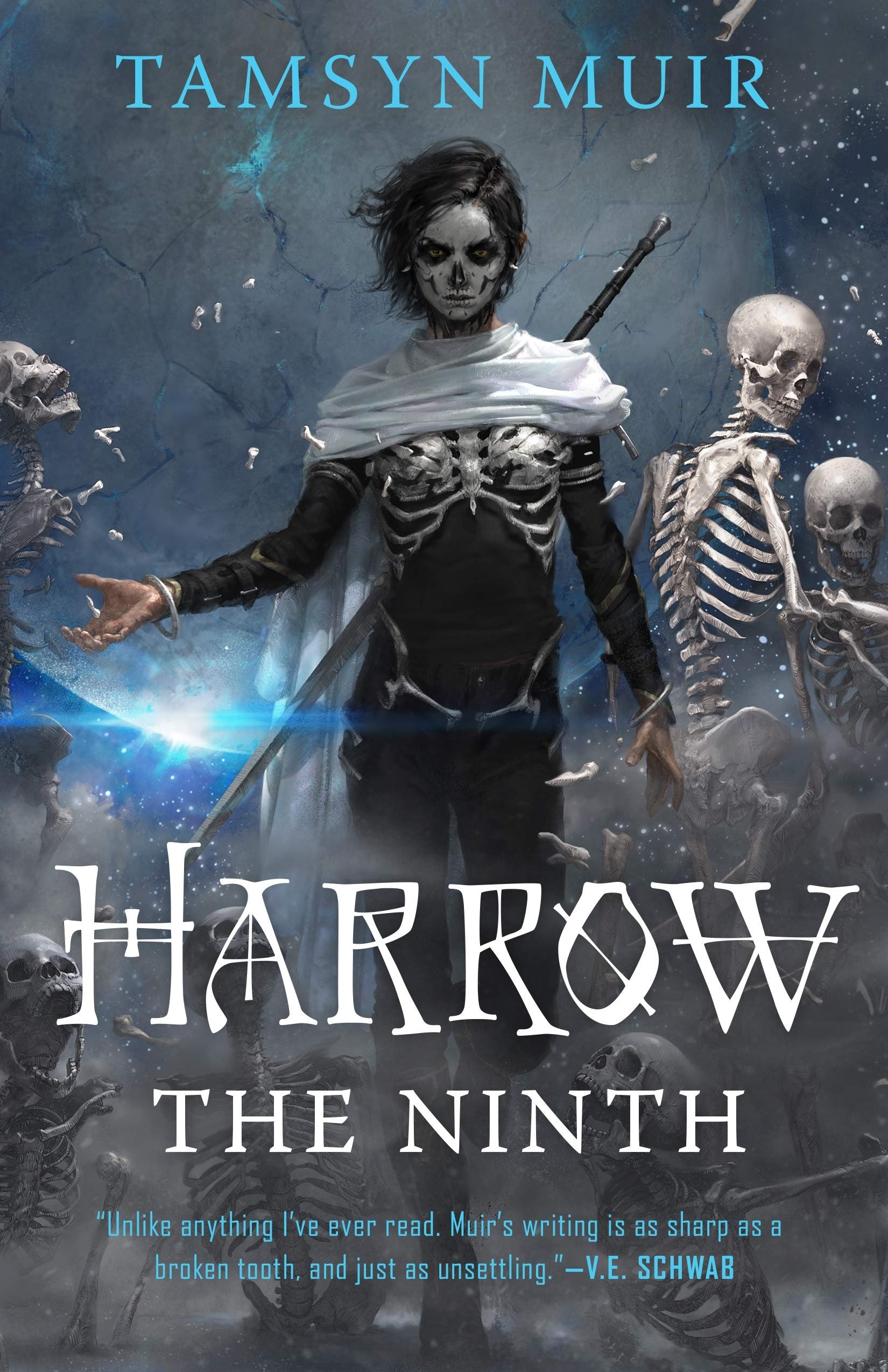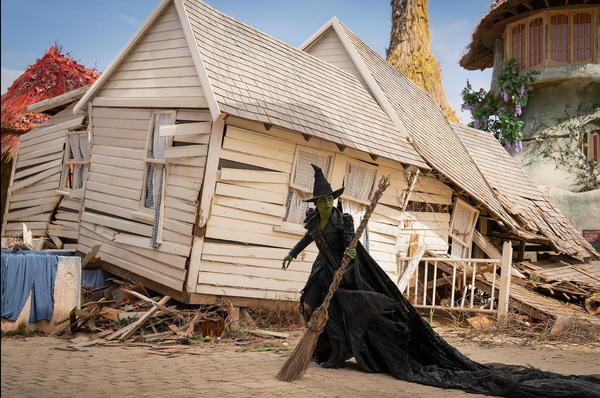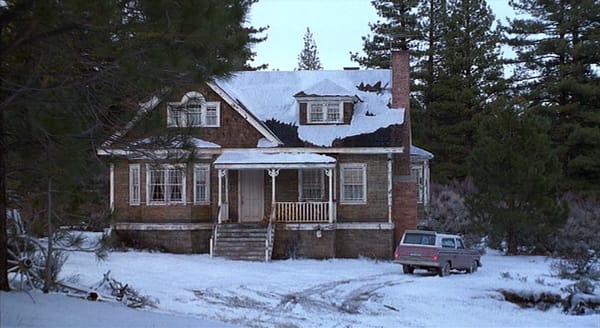How to write about trauma
On Susanna Clarke's Piranesi, Tamsyn Muir's Harrow the Ninth, and realizing your memories aren't your memories

But this was more than she could take stock of. Harrow was too amazed by her body’s expanding capacity for despair. It was as though her feeling doubled even as she looked at it, unfolding, like falling down an endless flight of stairs. —from Harrow the Ninth by Tamsyn Muir
The day before Thanksgiving 2019, I told a friend that I felt like I was walking on a high wire over an abyss. This was not a new feeling for me. I had always felt as though something inside of me was precariously perched atop something deep and dark and black. But when I began HRT in late 2018, I had hopes that I could at least make the abyss into a pit — a fall would hurt like hell, but it wouldn’t kill me. Instead, the floor of the abyss receded away from me. HRT had just revealed how thin the wire I stood upon always was.
The sudden realization that gender dysphoria is covering up other stuff your brain is unable or unwilling to confront when it’s cloaked in a fog of dysphoric spirals is one plenty of trans people report. The process of going on HRT, especially, seems to unlock doors in the brain that have long been closed. You suddenly start reexamining your life, realizing just how depersonalized and dissociated you always were. The act of pulling yourself back together inevitably reveals that some shards went missing along the way.
The same friend I had that conversation about the abyss with has suggested to me, frequently, that growing up trans is its own kind of trauma, particularly if you make it to adulthood without self accepting. The constant grind of moving through a world that never quite sees you the way you want to be seen creates a disconnect between self and body that can widen into a chasm given enough time. And that’s to say nothing of how many of us are forcefully shoved toward our assigned gender at birth as children, an experience that can shatter a young brain.
But, I realized, there was more going on in my head than the reverberations of a life spend amid dysphoria. The abyss had never been about that, not really.

In Susanna Clarke’s slim but powerful new fantasy novel Piranesi, the titular character is a man trapped in an endless labyrinth of a House. It has several stories, and it seems to stretch on without end. You exit one room and come to another. Along the lower floors, a seeming ocean rolls. Piranesi can predict the tides. He knows when the floodwaters will rise.
Piranesi is the foremost expert on the House, the only one who knows how to navigate it with any accuracy. Of course, he’s the only one who lives here. Every so often, he communicates with a mysterious man known as The Other, and the bones of previous residents of the House are scattered throughout it until Piranesi offers an ad hoc burial for the skeletons he finds. But for the most part, he seems to be completely alone.
For the first 20 pages or so, you might be forgiven for thinking Clarke was crafting a tale largely without a plot. If she had done so, it would have been more than fine. Clarke is a master of atmosphere, and the House is an atmosphere unlike others I’ve read in fantasy literature. It probably comes closest to Castle Gormenghast, the strange building in Mervyn Peake’s Gormenghast series that seems almost an ecosystem unto itself. But the House’s mashup of ancient and modern, classical and neoclassical, suggests there is more here than meets the eye. The book is a fantasy novel, to be sure, but one that is interested in which doors lead to the House and which might lead out of it.
Also, Piranesi is about trauma.
Every since I self accepted, I’ve described my inner self as a house. The place that I thought I lived turned out to be an attic, and once I managed to open the door, I discovered a massive, Gothic construction straight out of Guillermo Del Toro or any given Bronte sister. It was windy and derelict. No one had been taking care of it. To do so would be the work of the rest of my life. But it was my house. I got to live here.
There were other people here, too, facets of myself I had let wander away as I shut down more off my essential functions to just stay alive. My joy and rage and sadness were all here, as well as the extroversion I had thought lost somewhere in college. The pieces of myself that I needed to make myself a full person instead of a simulacrum of one were all hiding, like Pokemon, but I could, indeed, catch ‘em all.
Yet every time I became comfortable with the layout of the house, I would discover that it was larger than I thought possible. There was another wing or another floor or a basement. And the more I became comfortable with the thought of never having a map that would work entirely properly, the more I realized the house was haunted, peopled by ghosts and monsters that were, apparently, part of me too.
It is difficult to explain precisely how this links up with Piranesi without spoiling Piranesi (though I will say that the book does not all take place in somebody’s head, which is good). Suffice to say that the House where Piranesi is lost is both real and not real, both metaphor and actuality. There is a firmness to it that can be mapped; it always feels as if it will dissolve into mist. From here on out Spoilers Will Follow, and I will mark when it’s safe to come back. (For what it’s worth, Piranesi is structured like a mystery, which means that at least some of its pleasures lie in finding out What’s Really Going On, but it gains most of its power from Clarke’s artful use of atmosphere and symbolism. This is a book that is enjoyable both for the quality of its writing and its plot.)
SPOILER TOWN SPOILER TOWN SPOILER TOWN
The man known to readers as “Piranesi” is actually one Matthew Rose Sorenson, a graduate student researching the works of a largely discredited scholar who hoped to open gates between worlds. It turns out the scholar was successful, but only insofar as he built a link to one other world — the House. It’s strongly implied the House is a sort of world between worlds, where the flotsam and jetsam of our reality keeps washing up. The many statues of Earth objects found in the house appear to be automatically generated replicas of things on our plane.
People who are trapped within the labyrinth tend to slowly lose their minds and forget who they were or where they were from. So it goes with Piranesi, who has no idea that he is actually Sorenson or that he is from our own reality. (Readers are clued in that something is going on quite early, when it becomes clear the Other is looking at a smartphone.) Piranesi was trapped in the House by the Other, long ago, but the Other eventually convinced Piranesi that he was Piranesi’s protector.
Piranesi, then, is lost in an endless cycle of abuse, where he becomes convinced that his abuser is actually his protector. No longer able to look clearly at the situation he finds himself trapped in, he eventually breaks entirely with his old self. Even when he escapes the House (as you know he must), he finds it all but impossible to think of himself as Sorenson. The trauma has so shaped him that he is now a fundamentally different person.
The last section of the book takes place in our reality. The business of the plot wrapped up, Clarke gives the last several pages of the novel over to Piranesi’s attempts to reintegrate into our world. Yet no matter where he goes, he is still swallowed by the House. She writes:
People were walking up and down on the path. An old man passed me. He looked sad and tired. He had broken veins on his cheeks and a bristly white beard. As he screwed up his eyes against the falling snow, I realised I knew him. He is depicted on the northern wall of the forty-eighth western hall. He is shown as a king with a little model of a walled city in one hand while the other hand he raises in blessing. I wanted to seize hold of him and say to him: In another world you are a king, noble and good! I have seen it! But I hesitated a moment too long and he disappeared into the crowd.
Piranesi, lost for so long in the halls of the House, can only understand our reality through the prism of the years he lost. He can be outside in a park, and still, the House will come for him.
THE SPOILERS ARE OVER. YOU CAN COME BACK NOW!
Tamsyn Muir’s Gideon the Ninth was one of the sci-fi/fantasy success stories of 2019, a plot-heavy blast of a book that somehow mashed up The Hunger Games, Buffy the Vampire Slayer lesbian slashfic, Cronenbergian body horror, the concept art for Alejandro Jodorowsky’s never-produced film adaptation of Dune, and My Chemical Romance’s Welcome to the Black Parade. People didn’t just love that book. They evangelized for that book.
I really liked it! I did. It was a fun read, Gideon herself was a blast of a character, and the “enemies to allies to friends to maybe more???” at the book’s center (between Gideon and the Princess Harrowhark) was really well handled. But I found the book a bit top heavy. Muir seemed so enamored of her many, many ideas that I found myself perpetually lost in a thicket of trying to figure out who certain characters were and what their magic powers were supposed to be. (Because, yes, this book is about, as the pull quote would have it, “lesbian necromancers… in space.”)
Yet the ending of the book was so very satisfying that I was at least somewhat inclined to pick up the sequel (published this year). When I learned that the point-of-view character shifted to Harrowhark, a character I had glommed onto hard without really understanding why, I didn’t just decide to pick up the sequel. I bought it (after waiting for ages to check out Gideon from the library).
Essentially every review of Harrow the Ninth has said that the book is challenging to read but rewarding in the end. Muir throws so many obstacles in the way of you just sitting back and enjoying this fucking novel that it’s a wonder she doesn’t burn all of the goodwill Gideon earned her. The book is in second person. It’s told across a fractured timeline where you really have to be paying attention to figure out which events lock together with which other ones. It essentially negates the events of the wildly popular first book in its first chapter, lest you be excited to pick up right where Muir left off.
And Harrow herself is a deeply unreliable narrator. She remembers the events of the first book completely differently from how they “actually” happened, and she is not always focused on the right things at the right time. She’s an 18-year-old who was raised by monster people in order to become a monster person herself, and she’s desperately clinging to what’s left of her humanity, even though she’s now supposed to be training to be a kind of super rad space Nazgul, serving the so-called “Necrolord Prime,” who’s just a random dude named John who figured out how to resurrect people and thus created the world of Muir’s novels.
To be clear: All of the above is established in the first 50 pages of a 500-page novel. Like I said, Muir keeps throwing obstacles in the way of you enjoying or even understanding this thing. It’s dense, even more top-heavy than its predecessor, and so scattered as to seem almost completely incomprehensible. That Muir keeps the story from atomizing shows what a gifted writer she is. But for many “It doesn’t completely fall apart in the end!” will be cold comfort as they’re slogging through the book’s midsection.
This is where I tell you that I fucking love this book. I love it in the way everybody else loved Gideon the Ninth. I would die for this book. This book, at every turn, made perfect sense to me, to the degree that I came to realize Harrow and I perceive the world in basically the same way — as a fragmented series of choices that can never be undone and a gradually growing certainty that your real self is in the next castle.
If you’ve read Gideon, then you know that Gideon and Harrowhark are the only two children from an entire generation to survive a disease that was spread by Harrow’s parents to allow their tiny baby to suck up so much death energy that she couldn’t help but become a supercharged necromancer, a thing that basically worked. (Gideon’s survival remains unexplained. PROBABLY IT’S BECAUSE SHE AND HARROW ARE IN LOVE.) But if you can imagine that being raised by two people who killed an entire generation would warp you a little bit, you haven’t even begun to imagine how badly Harrow has been broken by the life she was born into.

There’s an interesting bit of sleight of hand deployed by Muir here. All of those children really did die to supercharge Harrowhark. She is, on some level, a monstrous creation of monsters. We are hearing her story because she is the baby who lived, not one of the many, many children who died. But Harrow was not the one who killed those children. Her parents’ actions have given her oceans of privilege and power from which to draw, but they have also turned her into an immense receptacle for pain. She is detached and dissociated. She doesn’t think of herself as a real person so much as a character in a story.
The second person narration underlines this idea of dissociation as a psychological counterbalance to the weight of trauma. Reading a book that is written largely as “You do this” and “You do that” can end up being tedious, but the degree to which this choice immediately drew me in is perhaps telling.
Here’s a passage that made me cry:
If Ianthe reached out to touch your arm, you were afraid you might not understand whose arm she was touching. You were so afraid she might touch you. You were so afraid anyone might touch you. You had always been afraid o anyone touching you, and had not known your longing flinch was so obvious to those who tried it.
Fuck, I thought. Is that me?
Fictional approaches to trauma will be different for every reader and for every writer. In the second season of my audio fiction podcast Arden, for instance, the characters of Dana Hamill and Olivia Breckenridge have different relationships to the horrible things that have happened to them over their lives. They have varying degrees of willingness to look at those things head-on.
Arden takes place in a more or less “real” universe. Yes, it’s a heightened, comedic place. But the characters exist within our plane of reality. Therefore, whatever trauma they have lived through has to be recognizable as trauma you might hear a best friend discussing or something similar. You can’t suddenly be, like, “And the reason Dana is such a great singer-songwriter is because her parents killed a bunch of baby singer-songwriters when she was young!” It would break the show.
But Arden isn’t just about trauma. There are a bunch of other things going on, too, which means that our occasional forays into stories about the ways that people bruise each other, sometimes without meaning to, don’t have to carry the burden of the main plot. Since we’re a comedy, a romance, and a mystery (in roughly that order), we can occasionally turn the show over to other, more dramatic stuff without making it all about that.
If you actually want to tell a story about trauma, if you want to look it dead in the eyes and put it at the center of your story, that becomes a trickier prospect. I think often of Hanya Yanigahara’s massive 2015 novel A Little Life, which details the relationships among four friends, one of whom suffered just catastrophic amounts of abuse as a child. The book offers detailed litanies of what that abuse looked like, and at a certain point, the unrelenting list of horrible things starts to numb the brain.
I think this is at least partially intentional on Yanigahara’s part. Abuse survivors often suggest that their brains fuzz out many of the details, because they’re too painful to hold onto. (We see similar effects in those who struggle with combat PTSD.) The reader becoming numb to the litany of horrors parallels the numbness of the abuse survivor, which creates a sympathy for why the abuse survivor might find their thoughts turning increasingly dark and dispirited.
But to get there, Yanigahara has to become so detailed and so over the top that she risks turning her book into exploitative, blood-soaked grand guignol. By the 50th passage about a character’s wounds, you start to feel as though the book’s ability to move you is secondary to its insistence on shocking you. And this is a book I mostly like, one that I think captures certain qualities of living with trauma quite well. There are so many other books where trauma becomes a rare butterfly that can be captured and pinned down under glass. If we can understand it, we can remove its mystery and its danger, the thinking goes.
The thing I’m slowly realizing about recovering memories — even happy memories you’ve buried for unspecified reasons (turns out this is a thing!) — and about processing trauma is that when you try to describe it, it sounds really fucking weird. Yes, there are people who have very firm lists of the bad things that happened to them, and they can often outline those things with varying degrees of detachment or passion, but many, many, many people discover they live inside an origami construction, one that unfolds to reveal something new, which further unfolds to reveal still other mysteries. You’ll have a memory that feels stable and firm, and then you’ll put one foot wrong and realize how wobbly you’ve become.
It’s hard to capture this in fiction, particularly realistic fiction. It’s certainly not impossible, and there are numerous strategies you could use to avoid the “pinning the trauma down” problem I described above. But of late, I’ve found myself thinking that perhaps genre fiction is where stories about trauma most naturally exist. Both Piranesi and Harrow the Ninth are about people raised by abusers, who learn to throw off those shackles and question the narratives they’ve constructed for themselves.
But doing that is painful. It takes time. It takes effort. And it takes overcoming herculean odds. It is a story about the triumph of the human spirit that is somehow the opposite of inspirational. The trials of waking up another day and forcing yourself through the paces of a life that keeps letting you down are certainly possible to explore in the context of more realistic storytelling, but why not cast them in relief via a strange House with an ocean inside or via a necromancer bopping about space?
I don’t know what I know.
For most of my life, my family praised me for how good my memory was, for the way that I could tell you, with great specificity, that my family went on this vacation in 1997 and then I did this other thing in 1995, and my sister and I did this in 1999, and so on. And this is more or less true. I have a firm memory of the events of my life.
But do I? The longer I tug at memories that I’ve held onto for years for no apparent reason, memories that have nothing to do with anything, the more I realize they’re connected to a lot of stuff I need to untangle. And to be clear: I could get to the core of these issues and discover that I more or less knew what was true; I just had to figure out a way to sort that into the context of my gender dysphoria.
Yet I cannot escape a growing feeling that this big, dilapidated old house I found myself in isn’t where I actually live. I sometimes feel as if I live next door to myself, as though the real me is in a bungalow just down the street that is guarded by wolves. It is impossible not to talk about this in the language of fairy tales, because what is happening to me feels not concrete but mutable, as though my past is a series of lies that a bunch of people asked me to agree upon, an official story told by a strict state.
I don’t know where any of this is going. I want to land at the bottom of this abyss and find myself on a mundane suburban street, where the “real” me comes to the door and asks me what took me so long, where the wolves end up being normal dogs. But I no longer know which steps will be firm and which walls will hold. Memories come and go, and it’s easy enough to assume some of them aren’t real, even if the way they make me feel suggests they very much are.
That I hadn’t ever read a book that felt quite like this experience until this year, when I read Piranesi and Harrow the Ninth speaks to how good these books are at speaking to what it means to live with trauma. But I hadn’t ever read a book that felt quite like this experience until this year because it was only this year in which I allowed myself to admit I was having this experience. For a long time, I knew who I was, and then, like Harrow the Ninth, I found my feeling doubling even as I looked at it, “unfolding, like falling down an endless flight of stairs.”
Public service announcement: Don’t forget that a paid edition of Episodes is coming very soon! Read details here.
What I’ve been up to: It was a good week for me recommending random things I enjoy at Vox, thanks to this piece on Selena Gomez’s album Rare and this one on Netflix’s super entertaining new YA romance Dash & Lily:
If there’s one thing I know for sure about myself, it’s this: I would be amazing at taking part in a whirlwind love story that unfolds during a romantically charged week at Christmastime in New York. From the meet-cute to the unexpected connection with a total stranger, it’s something I feel born to do.
Alas, I live in Los Angeles, and even if I lived in New York, now doesn’t seem like the best time to be having a whirlwind love story with someone I’ve never met. So I’ll just have to live out my dreams vicariously through a Netflix young adult series!
Read me: My friend Sydney Bauer has an amazing piece on the mental health burden the pandemic has placed on LGBTQ people in particular. Read it now.
Sydney Duncan, 44, an attorney in Alabama, has been so focused on managing the increased legal needs of her clients that she rarely has time to address her own mental health needs, including her anxiety.
Since the start of the coronavirus pandemic, Duncan has devoted nearly her whole waking day to her work at Birmingham AIDS Outreach, an Alabama nonprofit. Helping her transgender clients obtain vital name changes has become a prolonged process due to court backlogs piling up, helping them acquire driver's licenses has become harder while Social Security offices are closed, and increased unemployment among the community she serves has complicated a variety of services her nonprofit provides.
“We're so busy trying to resolve other people's issues — which objectively are more pressing than anything I have going on in my life — that it's hard to slow down and feel the weight of the problems in your own life,” Duncan said.
Watch me: If you’re looking for something slightly out of the ordinary to watch this holiday season, can I suggest It Happened on Fifth Avenue? The 1947 film about a group of unhoused people who end up crashing in a rich man’s mansion is warm and funny, and I was surprised at how much its politics argued, in essence, for universal public housing. Plus, the leading lady wears some amazing dresses. How can you go wrong with a film where the poster proclaims “The world’s second richest man switches places with a hobo!”?
And another thing… If you have Queen’s Gambit fever, as so much of America does, this Twitter thread by somebody who actually knows her chess breaks down every single game in the show to reveal the strategy behind the chess in the show. And it turns out a lot of it is really well handled!
So today I was put in touch with a local news organization who wants to interview me about The Queen's Gambit, since there are like zero women in chess, so I guess I have to actually watch this now.
Reaction thread? Reaction thread.November 18, 2020
This week’s reading music: “Anthems for a Seventeen Year Old Girl” by Broken Social Scene.
Episodes is published once per week and is about whatever I feel like that particular week. Suggest topics for future installments via email or on Twitter. Read more of my work at Vox.




